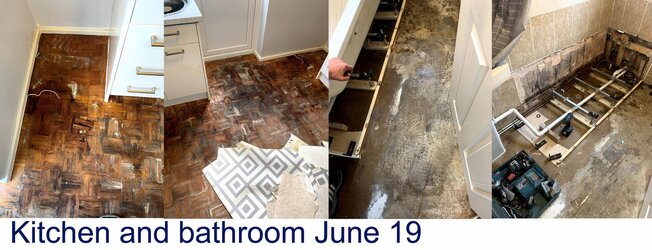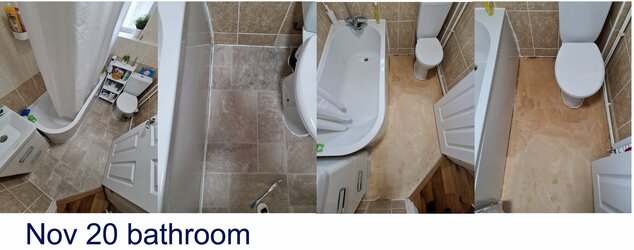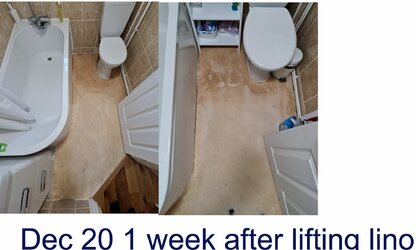Morning all. I found this forum via this thread (and Google). It's as close to my own situation that I have found so far, so hoping for some advice from you experts. I've done a lot of reading and know this is a difficult one to diagnose remotely - so have included as much detail as possible. Sorry, its a long one.
I bought a 1950's semi 3 years ago and have been fighting damp on our bathroom floor ever since. I'm losing!
The bathroom is adjacent to the kitchen, both on the ground floor. Bathroom has two outside walls.
All work to date has been performed by tradesmen.
Here's a timeline.
Moved in June 17. Previous owner fitted new bathroom May 17. Kitchen had original parquet floor.
June 18. Lino laid directly over kitchen parquet floor and siliconed around edges.
June 19. Noticed black patches on kitchen lino. Pulled up and found damp under lino. Advised lino should not have been laid as floor could not breathe. Removed parquet, screeded and relaid new lino. So far, kitchen seems OK.
Also checked under bathroom lino and found concrete is wet.
Suspected that cheap bath is flexing and water falling behind tiles and under floor. Replaced bath with rigid one, screeded and relaid new vinyl floor (5mm, felt backed, "waterproof").
Replaced extractor fan with timer version off light (30 min).
Nov 20. New lino also showing damp patches. Removed and found floor wet around toilet and outside wall. Had a call with a damp expert who said it cannot be coming from floor as there is a DPM (can just about see from outside wall) and fitted vinyl has a waterproof layer - https://www.tapi.co.uk/vinyl/grande-ferra
But as damp is showing on both sides of vinyl, I don't see how this can be true.... So he is stumped and suggested the screed is just "sweating".
So now I need to replace the flooring again, and have been told tiles with waterproof backer boards will likely stop any further issues. I'm concerned that this is just hiding the underlying issue. In 12 months, we are planning an extension that will mean the bathroom will have no outside walls (but will have a big jet engine extractor!).
There is a lot of condensation on the cistern so I'm also planning on replacing the toilet with a concealed plastic cistern and replacing the wax seal on soil stack pipe prior to tiling, just in case this is leaking.
Should a liquid DPM be applied to the screed first? Above thread mentions Xytex, which seems fantastic. Would this, applied before waterproof backer boards and tiles resolve the issue, or am I going to find myself in the same situation in a year?
One concern I have is that under the bath has not been screeded and cannot be tiled without removing (don't really want to do this). Cost is also a factor here - cant really afford to lift and reinstall furniture, more screeding and UFH etc...
Any help, advice or opinions most welcome. Thanks for reading.
I bought a 1950's semi 3 years ago and have been fighting damp on our bathroom floor ever since. I'm losing!
The bathroom is adjacent to the kitchen, both on the ground floor. Bathroom has two outside walls.
All work to date has been performed by tradesmen.
Here's a timeline.
Moved in June 17. Previous owner fitted new bathroom May 17. Kitchen had original parquet floor.
June 18. Lino laid directly over kitchen parquet floor and siliconed around edges.
June 19. Noticed black patches on kitchen lino. Pulled up and found damp under lino. Advised lino should not have been laid as floor could not breathe. Removed parquet, screeded and relaid new lino. So far, kitchen seems OK.
Also checked under bathroom lino and found concrete is wet.
Suspected that cheap bath is flexing and water falling behind tiles and under floor. Replaced bath with rigid one, screeded and relaid new vinyl floor (5mm, felt backed, "waterproof").
Replaced extractor fan with timer version off light (30 min).
Nov 20. New lino also showing damp patches. Removed and found floor wet around toilet and outside wall. Had a call with a damp expert who said it cannot be coming from floor as there is a DPM (can just about see from outside wall) and fitted vinyl has a waterproof layer - https://www.tapi.co.uk/vinyl/grande-ferra
But as damp is showing on both sides of vinyl, I don't see how this can be true.... So he is stumped and suggested the screed is just "sweating".
So now I need to replace the flooring again, and have been told tiles with waterproof backer boards will likely stop any further issues. I'm concerned that this is just hiding the underlying issue. In 12 months, we are planning an extension that will mean the bathroom will have no outside walls (but will have a big jet engine extractor!).
There is a lot of condensation on the cistern so I'm also planning on replacing the toilet with a concealed plastic cistern and replacing the wax seal on soil stack pipe prior to tiling, just in case this is leaking.
Should a liquid DPM be applied to the screed first? Above thread mentions Xytex, which seems fantastic. Would this, applied before waterproof backer boards and tiles resolve the issue, or am I going to find myself in the same situation in a year?
One concern I have is that under the bath has not been screeded and cannot be tiled without removing (don't really want to do this). Cost is also a factor here - cant really afford to lift and reinstall furniture, more screeding and UFH etc...
Any help, advice or opinions most welcome. Thanks for reading.
Attachments
Last edited:



